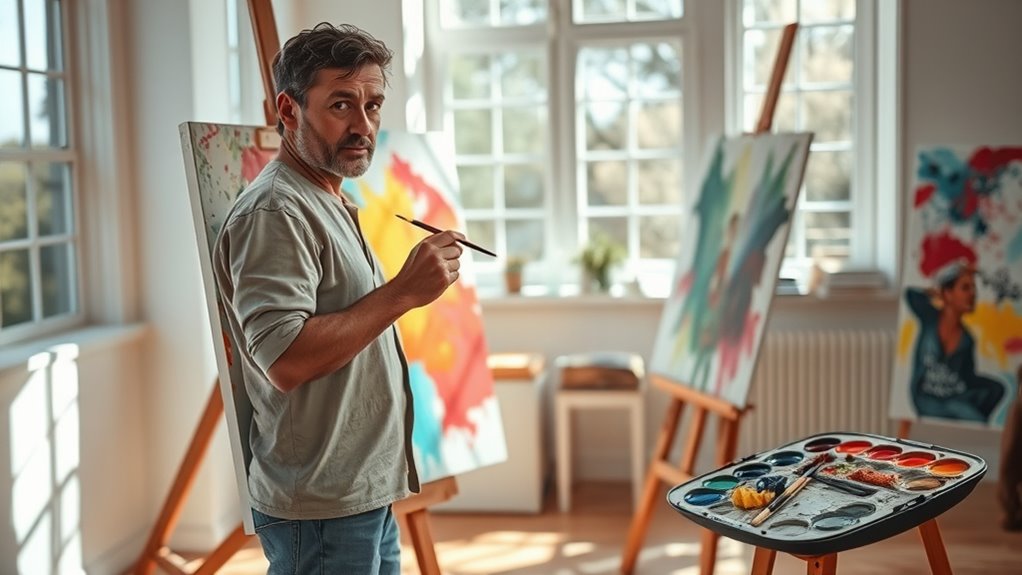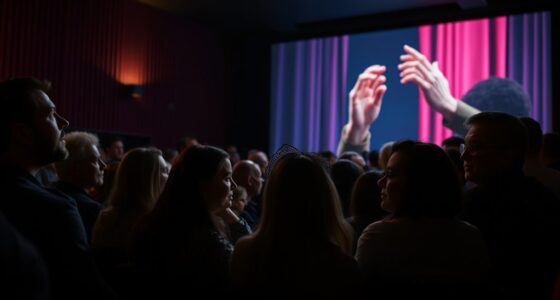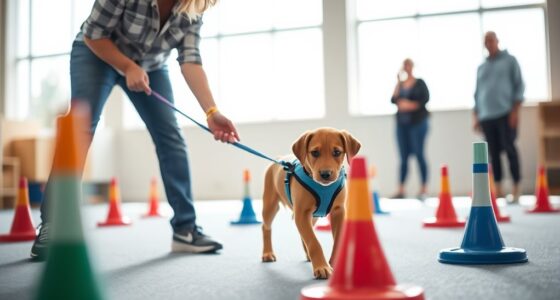If you’re looking to explore unique artistic perspectives, you’ve got to check out Deaf artists reshaping the creative scene. From innovative culinary creations by Deaf chefs to stunning visual arts at festivals, their work celebrates culture in vibrant ways. Attend events like the Deaf Arts Festival NI or workshops that spotlight their talents. Plus, you’ll find thriving art centers offering fresh insights. Keep an eye on these influential voices—they’re making waves in the art world and beyond.
Key Takeaways
- Berenika Burska’s installations, like *Bezgłosy*, deeply explore Deaf experiences through striking visual art.
- Deaf artists contribute significantly to cultural narratives, enriching the art world with diverse perspectives.
- Attend festivals like the Deaf Visual Arts Festival to discover and support emerging Deaf talent.
- RIT/NTID’s Deaf Artists Website connects over 100 Deaf artists, showcasing their work and providing resources.
- Engage with organizations like Deaf Spotlight to stay updated on Deaf artistic expressions and community events.
Celebrating Deaf Artistic Expression

When you explore the world of Deaf artistic expression, you’ll find that it extends beyond visual arts to innovative culinary creations. Deaf chefs are redefining flavors and showcasing their unique perspectives through food. This celebration of Deaf artistry in the kitchen highlights their creativity and cultural identity, inviting everyone to savor their delicious contributions. The Deaf Art Movement has significantly influenced various forms of artistic expression, including culinary arts, as Deaf individuals continue to break boundaries. This creativity can be cultivated by anyone, regardless of skill level, showcasing that artistic expression knows no limits.
Deaf Chefs’ Innovative Flavors
Deaf chefs are redefining culinary artistry by blending innovative techniques with rich cultural traditions, creating a vibrant tapestry of flavors that captivates all who experience their dishes. Their work reflects a global exchange of ideas, incorporating local ingredients and unique cooking methods like visual timers and silent dining to enhance sensory experiences. Deaf cuisine is characterized by its ability to reflect the diverse places where Deaf individuals have lived, enriching the culinary landscape. Incorporating elements of healthy breakfast can further elevate their dishes, providing nutritious options that appeal to a wider audience. Themed breakfasts, such as those focusing on seasonal themes, can create exciting opportunities for these chefs to showcase their unique flavors. Signature dishes, such as Deaf Chili and Hand Talk Soup, showcase community bonding and storytelling through food. Additionally, innovative cooking techniques, like solar-powered appliances, can help these chefs create their dishes sustainably while reducing their carbon footprint. Despite facing challenges like communication barriers, these chefs use innovative solutions and accessible online platforms to thrive. Events like the Deaf Culinary Festival highlight their talents, while Deaf-owned restaurants serve as cultural hubs, inviting everyone to enjoy delicious food and learn about Deaf culture. Furthermore, the use of juice cleansing as a method to incorporate healthy ingredients can enhance their menus while promoting wellness.
Vibrant Artistic Communities

You’ll find that vibrant artistic communities are essential for supporting and showcasing Deaf artists. From thriving Deaf art centers to underrated exhibits, these spaces amplify diverse voices. Additionally, engaging with astrological compatibility can enhance the interpersonal connections within these communities. Plus, attending a Deaf art festival can immerse you in the rich tapestry of creativity and culture within the Deaf community. It’s important to recognize the contributions of deaf artists throughout history, as their unique perspectives have significantly enriched the art world. Furthermore, the use of sound healing techniques can promote emotional well-being and creativity among artists, enhancing their artistic expression. Additionally, the establishment of support networks for artists can foster collaboration and encourage the growth of individual creative expressions. Engaging with meaningful experiences in these communities can further enhance the visibility and appreciation of Deaf artistry.
Thriving Deaf Art Centers
Art centers dedicated to Deaf culture are thriving, creating vibrant artistic communities that celebrate unique expressions and narratives. The Deaf Culture Centre in Toronto promotes Deaf culture through art and performances, while Pyramid Atlantic Art Center in Maryland hosts exhibitions featuring Deaf artists, fostering community engagement. The Deaf Culture Centre aims to enhance visitor experience in a signing environment, furthering the appreciation of Deaf culture. Additionally, these centers often emphasize the importance of proper disposal methods to maintain clean and healthy environments for artistic expression. Furthermore, these artistic communities often reflect cultural influences that shape emotional experiences and narratives within Deaf culture. Understanding the significance of emotional manipulation can also enhance the artistic storytelling within these communities.
In Minnesota, the Anderson Center offers a Deaf Artists Residency Program, providing a safe space for growth and encouraging unbeatable savings in art supplies for emerging artists. Meanwhile, Deaf Mosaic in the UK highlights Deaf achievements in mainstream venues, inspiring important conversations.
The Finnish Museum of the Deaf showcases Deaf history and culture, reaching global audiences through virtual exhibitions. Together, these centers not only uplift Deaf artists but also challenge societal barriers, reinforcing the significance of diverse voices in the art world.
Underrated Deaf Art Exhibits
While many art exhibits capture mainstream attention, several underrated Deaf art exhibits deserve recognition for their unique perspectives and vibrant creativity.
Berenika Burska’s *Bezgłosy* explores Deaf experiences through striking installations, like butterfly wings, symbolizing transformation and identity, emphasizing the challenges faced by Deaf individuals. Additionally, the emotional depth found in her work resonates with the importance of compassion and kindness in understanding diverse experiences. Furthermore, her installations reflect the growing interest in new Bitcoin holders as they reshape market dynamics and cultural narratives. This artistic exploration encourages viewers to embrace emotional instability, similarly experienced by individuals with other marginalized identities.
Meanwhile, *Feel the Music: Deaf Creatives in OUMA* immerses you in the world of Deaf artists inspired by music and vibration, featuring dynamic installations and performances.
Organizations like Deaf Spotlight work tirelessly to showcase Deaf talent, emphasizing community engagement and diversity.
Additionally, RIT/NTID’s Deaf Artists Website connects over 100 Deaf and hard of hearing artists, offering essential resources for artistic expression.
These exhibits not only challenge stereotypes but also enrich the cultural landscape, inviting you to experience the power of Deaf artistic themes.
Attend a Deaf Art Festival
Have you ever considered the vibrant experiences waiting at a Deaf art festival?
Attending events like the Deaf Visual Arts Festival or the Deaf Enlightenment & Arts Festival immerses you in a rich tapestry of creativity. You’ll witness stunning visual art, hear powerful ASL poetry, and enjoy performances that showcase unique talents. The Deaf Visual Arts Festival celebrates deaf artists and their artwork, providing a platform for their creative expressions. Festivals such as Deaf Arts Festival NI focus on access and representation, ensuring everyone can appreciate the work of d/Deaf artists. Workshops and panels provide insight into the industry, fostering connections between deaf and hearing communities.
Gallaudet University’s Deaf Way Festival brings global voices together, celebrating culture and artistic achievements.
Don’t miss the chance to engage and connect with these vibrant artistic communities!
Culinary Workshops With Deaf Chefs

In culinary workshops with Deaf chefs, you’ll discover the art of creating culinary masterpieces that highlight their unique perspectives. You can also explore craft beverages from nearby vineyards, enhancing your gastronomic journey. These experiences not only celebrate their skills but also break down barriers in the food service industry. Additionally, these workshops provide accessible culinary education that empowers clients with decision-making control over their training. Participants can also learn about the shelf life of freshly squeezed juices, ensuring they can make informed choices about preserving their culinary creations. Incorporating fresh ingredients in your juices can significantly enhance flavor and nutrition, making every sip a wholesome experience. Moreover, using fresh herbs like chamomile and ginger can not only elevate your juices but also provide health benefits, such as alleviating menstrual discomfort. Understanding the shelf life of juices is crucial for ensuring that your creations retain their flavor and quality over time.
Culinary Masterpieces by Deaf Chefs
Culinary workshops led by Deaf chefs not only showcase their incredible talent but also create inclusive spaces where everyone can learn and grow.
These workshops provide an opportunity to experience culinary masterpieces through hands-on training and collaboration. Here are some highlights you can expect:
- Delicious Dishes: Savor vibrant flavors in dishes that blend creativity with cultural significance. Assisted living expenses can influence the availability of such workshops, as funding opportunities may support broader participation. Additionally, these workshops often encourage comprehensive hearing evaluations to foster better communication among participants.
- Visual Cooking Techniques: Watch as chefs use visual cues and techniques to create stunning presentations, which allow for effective communication methods.
- Interactive Learning: Engage in an environment where ASL and cooking come together seamlessly.
- Empowering Stories: Hear inspiring journeys of Deaf chefs breaking barriers and redefining culinary arts.
Immerse yourself in these workshops and witness the beauty of inclusive cuisine crafted by talented Deaf chefs.
Craft Beverages From Nearby Vineyards
While you explore the delightful world of craft beverages, workshops featuring Deaf chefs can elevate your experience by pairing exquisite flavors with local wines and ciders.
Imagine sipping a invigorating Niagara cider, infused with peach and maple whisky, as a Deaf chef guides you through the perfect food pairings. Each winery, like Belle Âme Vineyard, offers scenic tastings that enhance the overall experience.
Visit Belle Ame Vineyard for scenic tastings or Cracked Barrel Winery, where you can enjoy wine slushies alongside artisan pizzas.
At Vineland Estates, you might even cozy up by the fireplace for a unique tasting experience.
Each vineyard offers something special, and with Deaf chefs at the helm, expect not only delicious food but also a deeper connection to the craft.
Your palate will thank you for this unforgettable journey!
Gastronomic Journeys With Deaf Chefs
Exploring the culinary arts with Deaf chefs opens up a world of flavors and techniques that can transform your cooking experience. Engaging in culinary workshops led by Deaf chefs not only enhances your skills but also fosters a rich cultural exchange. Here are four highlights you can expect:
- Hands-On Learning: Enjoy practical cooking sessions where you’ll learn through visual and tactile methods.
- Diverse Techniques: Discover unique cooking styles that showcase creativity and adaptability in the kitchen. Grassroots marketing can also serve as a powerful way to promote these workshops and reach a broader audience.
- Empowerment: Gain confidence as you master culinary skills while supporting Deaf culture.
- Inspiring Stories: Hear firsthand experiences from Deaf chefs who’ve overcome barriers to achieve success.
Join these gastronomic journeys and savor the delicious outcomes!
Must-See Sights

When you explore the world of Deaf art, don’t miss the historic Deaf heritage sites that tell powerful stories. Breathtaking national parks offer stunning backdrops for artistic collaborations in nature, creating unique experiences. Plus, attending local Deaf performances lets you witness the vibrant expressions of Deaf culture live. You might also discover the impact of Deaf View/Image Art as it encourages self-expression within the community.
Historic Deaf Heritage Sites
If you’re keen to discover the rich history of the Deaf community, Martha’s Vineyard offers a remarkable journey through its historic Deaf heritage sites.
Here are four must-see spots that will immerse you in this unique culture:
- Martha’s Vineyard Shared-Signed Language Community Auto Tour: Drive through the island, visiting significant locations like Lambert’s Cove and the Old Chilmark Center.
- Chilmark Library: Explore the Chilmark Deaf Community Digital Archive for fascinating insights into local Deaf history, including the preservation of Martha’s Vineyard Sign Language.
- Abel’s Hill Cemetery: Pay respects at the graves of notable Deaf community members, a poignant reminder of the island’s legacy.
- Martha’s Vineyard Museum: Investigate educational resources and archival documents that highlight hereditary deafness and sign language.
These sites not only celebrate Deaf heritage but also invite you to engage with its vibrant history.
Breathtaking National Parks
National parks offer some of the most breathtaking landscapes in the U.S., showcasing diverse natural wonders that captivate every visitor. From towering hoodoos to dramatic canyons, there’s a park for everyone. Here are some must-visit parks:
| Park Name | Unique Features | Location |
|---|---|---|
| Big Bend National Park, TX | Vast size and Rio Grande access | Texas |
| Glacier National Park, MT | 750+ miles of hiking trails | Montana |
| Bryce Canyon National Park, UT | Distinctive hoodoos | Utah |
| Black Canyon of the Gunnison, CO | Steep canyon walls | Colorado |
| Badlands National Park, SD | Unique rock formations | South Dakota |
Plan your visit in spring or fall for the best experience, and don’t forget your camera! Additionally, cruising through Glacier Bay National Park offers stunning views of massive tidewater glaciers and unique wildlife encounters.
Artistic Collaborations in Nature
While exploring the intersection of art and nature, you’ll discover how Deaf artists create powerful collaborations that reflect their unique perspectives. These projects not only celebrate the beauty of nature but also foster community engagement and awareness of Deaf culture.
Here are some must-see sights that highlight their innovative work:
- Nature as Canvas: Artists transform outdoor spaces into living art, blending natural landscapes with creative expression. Emily LaVelle, a proud Deaf artist, draws inspiration from her mother’s influence and her love for nature.
- Tactile Installations: Interactive pieces invite you to touch and experience art in a whole new way.
- Collaborative Workshops: Join Deaf artists and community members as they create together, sharing ideas and techniques.
- Seasonal Exhibitions: Witness the changing beauty of nature through artwork that captures the essence of each season.
Attend Local Deaf Performances
Experiencing local Deaf performances opens up a vibrant world of storytelling and artistry that celebrates Deaf culture.
You’ll find events like Deaf Days at the Cincinnati Museum Center, featuring ASL interpreted tours that make art accessible. On Saturday, October 5, from 10 a.m. to 2 p.m., free entry for members will provide an excellent opportunity to engage with the community.
Don’t miss performances from Deaf West Theatre, known for their innovative ASL storytelling that merges Deaf and hearing cultures.
NTPA Deaf Theatre combines both Deaf and hearing actors, creating inclusive narratives that resonate with everyone.
Check out Northeastern University’s Deaf community events for educational workshops and cultural celebrations.
With features like ASL interpreters and captioning software, these performances guarantee everyone can engage fully.
Immerse yourself in this enriching experience and support the Deaf artists that are reshaping the arts landscape!
Practical Tips

When planning your visit to see deaf artists, consider practical tips to improve your experience.
Think about how you’ll get there, where you’ll stay, and the best times to visit for events. Additionally, creating a deaf-friendly environment can enhance the overall experience for everyone involved.
Also, be mindful of local etiquette to guarantee respectful interactions with the deaf community.
Getting There
Creating an inclusive arts environment for deaf individuals requires thoughtful adjustments that can make a significant difference. Here are some practical tips to enhance accessibility:
- Adapt Spaces: Rearrange rooms into circular or U-shaped setups, ensuring everyone can easily see the instructor.
- Clear Communication: Use bold signage and visual cues to help deaf participants navigate and understand instructions.
- Train Staff: Equip all staff with the knowledge to adapt activities for deaf children and young people effectively. For instance, understanding the experiences of deaf ancestry can help staff connect better with participants.
- Visual Aids: Provide written or visual explanations for unfamiliar terms, especially in dance or music activities.
Getting Around
Maneuvering the world can be challenging for deaf individuals, but with the right strategies, getting around becomes much easier.
Utilize public transport systems that feature digital information screens and visual alerts to stay informed about stops and disruptions. Sign up for SMS alerts in cities like Grenoble and Auckland for real-time updates. Real-time information access is essential for ensuring safety and comfort during travel.
Mobile apps like Moovit and CityMapper can help plan your routes effectively. When using rideshare apps like Uber, take advantage of text-based communication options. Inform staff about your needs for visual assistance.
Embrace technology like videophones and captioned phones for smoother communication. By leveraging these resources, you can navigate your travels confidently and enjoyably.
Best Time to Visit
Curious about the best time to experience Deaf art events? Here’s when you should mark your calendar:
- Spring Exhibitions: Witness a burst of creativity with vibrant exhibitions that celebrate new ideas.
- Major Events: Attend iconic shows like the Whitney Biennial or Christine Sun Kim’s exhibition, usually scheduled at specific times.
- Community Gatherings: Engage with events like Deaf Spotlight in Seattle, often held throughout the year, fostering a sense of belonging. Additionally, don’t miss the 8th Annual Florida Deaf Art Show taking place on June 21-22, 2024.
- Virtual Access: Explore online platforms for year-round access to Deaf art, making it easier to connect with the community.
Plan your visit around these key times to fully immerse yourself in the unique world of Deaf art and culture!
Where to Stay
Finding the right place to stay is essential for experiencing Deaf art events comfortably. Look for accommodations that offer sign language support and have trained staff familiar with Deaf culture. Resorts focusing on Deaf travelers often provide a sign language environment and inclusive activities, enhancing your experience. Make sure the venue is ADA compliant, with visual signage and captioned media for easy navigation. Consider using indoor navigation apps for text-based guidance. If you need communication tools, check for interpreters and speech-to-text services. Prioritize places that honor your accommodation requests, ensuring a seamless and enjoyable stay. With the right choices, you’ll immerse yourself in the vibrant world of Deaf art without barriers, and you may also discover culturally enriching experiences that deepen your understanding of Deaf culture.
Local Etiquette
When engaging with Deaf individuals, it’s essential to show respect and understanding, as this fosters a more inclusive atmosphere.
Here are some practical tips to enhance your interactions:
- Get Their Attention: Use a gentle tap on the shoulder or a friendly wave.
- Communicate Clearly: Face the person while speaking to aid lip-reading; avoid shouting.
- Create a Comfortable Environment: Make sure the lighting is good and the space is free from distractions. This is particularly important as responsible writing emphasizes clear communication.
- Be Patient and Respectful: Maintain eye contact and don’t interrupt, allowing for open communication.
Pro Tip
To truly support Deaf artists, it’s vital to create an environment that fosters collaboration and understanding. Start by ensuring your art spaces are well-lit and have circular seating for better visibility and communication. Use visual cues during performances and rehearsals to help Deaf artists follow along easily. Provide written or visual explanations for any unfamiliar terms to aid their understanding. Additionally, promoting the visibility of Deaf artists is essential in helping bridge gaps between Deaf and hearing communities. Encourage collaboration among Deaf artists to build community and empower their voices. Additionally, offer staff training focused on the needs of Deaf artists. Remember to highlight visual elements and color symbolism in their work, allowing them to express their emotions intuitively.
Frequently Asked Questions
How Can I Support Deaf Artists in My Area?
To support Deaf artists in your area, start by attending local events like theater performances and art shows.
Promote accessibility by ensuring venues provide sign language interpreters and captions.
Engage with local Deaf organizations to stay informed about initiatives.
You can also educate yourself about Deaf culture through workshops and online courses.
Finally, consider purchasing artwork directly from Deaf artists to help sustain their creative endeavors and showcase their talent.
Are There Scholarships for Deaf Art Students?
Isn’t it ironic that in a world so rich in sound, there’s a wealth of opportunities for deaf art students?
Yes, there are scholarships tailored just for you! Programs like the AG Bell College Scholarship offer up to $10,000, while the Cochlear Scholarship gives $2,000 annually.
With various options available, you’ll find financial support that aligns with your unique journey and creativity.
Don’t miss out—apply and let your talent shine!
What Are the Common Challenges Deaf Artists Face?
Deaf artists face several common challenges that can hinder their careers. You might encounter communication barriers, like the lack of interpreters at events or limited access to sign language resources, making it tough to engage fully.
Social attitudes and stereotypes can further isolate you, while digital platforms often lack accessibility features, like captions. Economic constraints and marketing difficulties also create obstacles, making it essential to advocate for greater inclusion and support in the art world.
How Is Deaf Culture Represented in Visual Arts?
When it comes to visual arts, Deaf culture is represented loud and clear.
You’ll see vibrant colors, symbols like hands, and powerful storytelling that capture unique experiences. Artists use visual language to express identity and challenge stereotypes about communication.
The De’VIA movement plays a significant role, showcasing the rich tapestry of Deaf life. Through these artistic expressions, you can grasp the essence of Deaf culture and its contributions to the broader art world.
Where Can I Find Deaf Art Exhibitions Online?
You can find Deaf art exhibitions online at several platforms.
Check out the Deaf Art Website for a diverse range of artists, or explore the SOMArts Virtual Gallery, which celebrates Bay Area Deaf arts.
The Deaf Culture Centre also hosts engaging live and digital exhibitions.
For more resources, look at InfoGuides and RIT/NTID offerings that focus on Deaf artists and their work.
These platforms provide a rich insight into Deaf culture and creativity.
Conclusion
As you explore the vibrant world of Deaf artists, you might just stumble upon a gallery where a Deaf chef shares their culinary masterpieces, blending art and flavor in unexpected ways. You’ll find that each encounter enriches your understanding and appreciation of Deaf culture. So, whether you’re admiring a powerful painting or savoring a unique dish, you’re not just witnessing art—you’re experiencing a beautiful coincidence of creativity and community. Don’t miss out on this inspiring journey!











